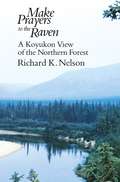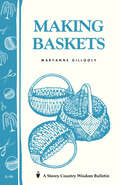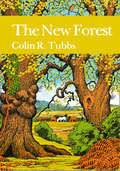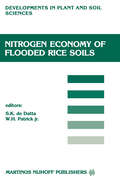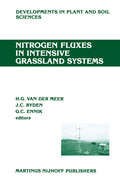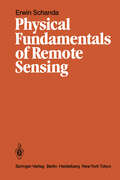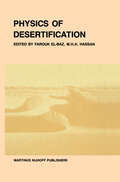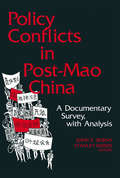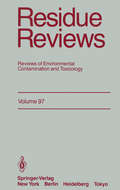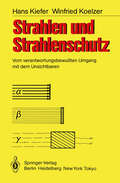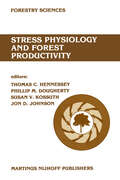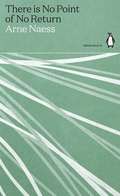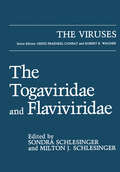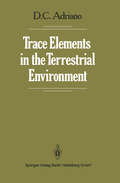- Table View
- List View
Make Prayers to the Raven: A Koyukon View of the Northern Forest
by Richard K. Nelson"Nelson spent a year among the Koyukon people of western Alaska, studying their intimate relationship with animals and the land. His chronicle of that visit represents a thorough and elegant account of the mystical connection between Native Americans and the natural world."—Outside "This admirable reflection on the natural history of the Koyukon River drainage in Alaska is founded on knowledge the author gained as a student of the Koyukon culture, indigenous to that region. He presents these Athapascan views of the land—principally of its animals and Koyukon relationships with those creatures—together with a measured account of his own experiences and doubts. . . . For someone in search of a native American expression of 'ecology' and natural history, I can think of no better place to begin than with this work."—Barry Lopez, Orion Nature Quarterly "Far from being a romantic attempt to pass on the spiritual lore of Native Americans for a quick fix by others, this is a very serious ethnographic study of some Alaskan Indians in the Northern Forest area. . . . He has painstakingly regarded their views of earth, sky, water, mammals and every creeping thing that creepeth upon the earth. He does admire their love of nature and spirit. Those who see the world through his eyes using their eyes will likely come away with new respect for the boreal forest and those who live with it and in it, not against it."—The Christian Century "In Make Prayers to the Raven Nelson reveals to us the Koyukon beliefs and attitudes toward the fauna that surround them in their forested habitat close to the lower Yukon. . . . Nelson's presentation also gives rich insights into the Koyukon subsistence cycle through the year and into the hardships of life in this northern region. The book is written with both brain and heart. . . . This book represents a landmark: never before has the integration of American Indians with their environment been so well spelled out."—Ake Hultkrantz, Journal of Forest History
Make Prayers to the Raven: A Koyukon View of the Northern Forest
by Richard K. Nelson"Nelson spent a year among the Koyukon people of western Alaska, studying their intimate relationship with animals and the land. His chronicle of that visit represents a thorough and elegant account of the mystical connection between Native Americans and the natural world."—Outside "This admirable reflection on the natural history of the Koyukon River drainage in Alaska is founded on knowledge the author gained as a student of the Koyukon culture, indigenous to that region. He presents these Athapascan views of the land—principally of its animals and Koyukon relationships with those creatures—together with a measured account of his own experiences and doubts. . . . For someone in search of a native American expression of 'ecology' and natural history, I can think of no better place to begin than with this work."—Barry Lopez, Orion Nature Quarterly "Far from being a romantic attempt to pass on the spiritual lore of Native Americans for a quick fix by others, this is a very serious ethnographic study of some Alaskan Indians in the Northern Forest area. . . . He has painstakingly regarded their views of earth, sky, water, mammals and every creeping thing that creepeth upon the earth. He does admire their love of nature and spirit. Those who see the world through his eyes using their eyes will likely come away with new respect for the boreal forest and those who live with it and in it, not against it."—The Christian Century "In Make Prayers to the Raven Nelson reveals to us the Koyukon beliefs and attitudes toward the fauna that surround them in their forested habitat close to the lower Yukon. . . . Nelson's presentation also gives rich insights into the Koyukon subsistence cycle through the year and into the hardships of life in this northern region. The book is written with both brain and heart. . . . This book represents a landmark: never before has the integration of American Indians with their environment been so well spelled out."—Ake Hultkrantz, Journal of Forest History
Make Prayers to the Raven: A Koyukon View of the Northern Forest
by Richard K. Nelson"Nelson spent a year among the Koyukon people of western Alaska, studying their intimate relationship with animals and the land. His chronicle of that visit represents a thorough and elegant account of the mystical connection between Native Americans and the natural world."—Outside "This admirable reflection on the natural history of the Koyukon River drainage in Alaska is founded on knowledge the author gained as a student of the Koyukon culture, indigenous to that region. He presents these Athapascan views of the land—principally of its animals and Koyukon relationships with those creatures—together with a measured account of his own experiences and doubts. . . . For someone in search of a native American expression of 'ecology' and natural history, I can think of no better place to begin than with this work."—Barry Lopez, Orion Nature Quarterly "Far from being a romantic attempt to pass on the spiritual lore of Native Americans for a quick fix by others, this is a very serious ethnographic study of some Alaskan Indians in the Northern Forest area. . . . He has painstakingly regarded their views of earth, sky, water, mammals and every creeping thing that creepeth upon the earth. He does admire their love of nature and spirit. Those who see the world through his eyes using their eyes will likely come away with new respect for the boreal forest and those who live with it and in it, not against it."—The Christian Century "In Make Prayers to the Raven Nelson reveals to us the Koyukon beliefs and attitudes toward the fauna that surround them in their forested habitat close to the lower Yukon. . . . Nelson's presentation also gives rich insights into the Koyukon subsistence cycle through the year and into the hardships of life in this northern region. The book is written with both brain and heart. . . . This book represents a landmark: never before has the integration of American Indians with their environment been so well spelled out."—Ake Hultkrantz, Journal of Forest History
Make Prayers to the Raven: A Koyukon View of the Northern Forest
by Richard K. Nelson"Nelson spent a year among the Koyukon people of western Alaska, studying their intimate relationship with animals and the land. His chronicle of that visit represents a thorough and elegant account of the mystical connection between Native Americans and the natural world."—Outside "This admirable reflection on the natural history of the Koyukon River drainage in Alaska is founded on knowledge the author gained as a student of the Koyukon culture, indigenous to that region. He presents these Athapascan views of the land—principally of its animals and Koyukon relationships with those creatures—together with a measured account of his own experiences and doubts. . . . For someone in search of a native American expression of 'ecology' and natural history, I can think of no better place to begin than with this work."—Barry Lopez, Orion Nature Quarterly "Far from being a romantic attempt to pass on the spiritual lore of Native Americans for a quick fix by others, this is a very serious ethnographic study of some Alaskan Indians in the Northern Forest area. . . . He has painstakingly regarded their views of earth, sky, water, mammals and every creeping thing that creepeth upon the earth. He does admire their love of nature and spirit. Those who see the world through his eyes using their eyes will likely come away with new respect for the boreal forest and those who live with it and in it, not against it."—The Christian Century "In Make Prayers to the Raven Nelson reveals to us the Koyukon beliefs and attitudes toward the fauna that surround them in their forested habitat close to the lower Yukon. . . . Nelson's presentation also gives rich insights into the Koyukon subsistence cycle through the year and into the hardships of life in this northern region. The book is written with both brain and heart. . . . This book represents a landmark: never before has the integration of American Indians with their environment been so well spelled out."—Ake Hultkrantz, Journal of Forest History
Making Baskets: Storey's Country Wisdom Bulletin A-96 (Storey Country Wisdom Bulletin)
by Maryanne GilloolySince 1973, Storey's Country Wisdom Bulletins have offered practical, hands-on instructions designed to help readers master dozens of country living skills quickly and easily. There are now more than 170 titles in this series, and their remarkable popularity reflects the common desire of country and city dwellers alike to cultivate personal independence in everyday life.
Management of Nitrogen and Phosphorus Fertilizers in Sub-Saharan Africa: Proceedings of a symposium, held in Lome, Togo, March 25–28, 1985 (Developments in Plant and Soil Sciences #24)
by Uzo M. Mokwunye Paul L. G. VlekFood security, one of the basic human rights, seems to be ever eluding the people of sub-Saharan Africa. With each occurrence of crop failure, agriculturalists around the world reawaken to the challenge of ensuring sta ble, adequate food production in the tropical African environments. The International Fertilizer Development Center (IFDC), with its mandate of alleviating food shortages through judicial use of fertilizers, formulated a program to study fertilizer use strategies for sub-Saharan Africa. With gener ous financial assistance from the International Fund for Agricultural Devel opment (IFAD), IFDC, in collaboration with the International Crop Re search Institute for the Semi-Arid Tropics (ICRISAT) and the International Institute for Tropical Agriculture (IIT A), initiated a research project aimed at assessing means to remedy soil nutrient deficiencies that constrain food production in the humid, subhumid, and semiarid tropics of Africa. The results of this project were summarized during a workshop held in Togo, March 25-28, 1985; the proceedings of that meetings are found in this vol ume. The project established collaboration with numerous national programs that were responsible for much of the data collection. The data presented in Chapters 6 and 9 include much of this information. We wish to acknowledge the contribution of the individual scientists, J.T. Ambe, F. Ganry, M. Gaoh, M. Issaka, J. Kiazolu, J. Kikafunde-Twine, K. Kpomblekou, F. Lompo, H.
Microfloral and faunal interactions in natural and agro-ecosystems (Developments in Biogeochemistry #3)
by M. J. Mitchell J. P. NakasMYRON J. MITCHELL* The biota of soils constitute an integral part of both natural and agronomic ecosystems. The soil microflora and fauna in conjunction with the belowground portion of the Metaphyta or higher plants constitute the living milieu, components of which are in intimate association with each other as well as the abiotic constituents of the soil. Since these associations or interactions are important in regulat ing both the flux and availability of energy and nutrients, the central theme of the present book focuses on these interactions. The effects of microfloral and faunal inter actions with regard to overall ecosystem dynamics and specific critical processes will be examined. HISTORICAL ASPECTS The coverage of this volume is an extension of a vast body of literature which dates back to the 18th century. A brief compendium of major books and reviews published from 1960 to 1983 is given chronologically in Tables 1 and 2, respectively. Russell (1961) has reviewed work in the 1800's during which some of the basic tenets on the relationships between plant nutrition and soil properties became estab lished. In this period agricultural science was founded and the study of soil bacteriology began. The evolution of soil biology up to the early 1970's has been described by Satch211 in the volume edited by Dickinson and Pugh (1974). *Department of Environmental and Forest Biology, SUNY, College of Environmental Science and Forestry, Syracuse, NY 13210 2 ~ .
The New Forest (Collins New Naturalist Library #73)
by Colin R. TubbsHow and why the New Forest has evolved to be an area of international importance – and Britain's richest 'nature reserve'.
Nitrogen Economy of Flooded Rice Soils: Proceedings of a symposium on the Nitrogen Economy of Flooded Rice Soils, Washington DC, 1983 (Developments in Plant and Soil Sciences #26)
by S. K. De Datta W. H. PatrickThe steadily increasing cost of nitrogen fertilizer has resulted in more emphasis on basic and applied studies to improve nitrogen use efficiency in lowland rice. The efficiency of fertilizer nitrogen in farmers' fields is shockingly low ~ a luxury resource-scarce farmers in tropical Asia can ill afford. We believe it is critical to quantify the basic transformation processes and develop management practices for higher N use efficiency for two reasons. They are: 1. Nitrogen fertilizer together with water management is a key factor for achieving the yield potentials of modern rices. 2. Fertilizer nitrogen prices are high and most Asian rice farmers are poor. The International Rice Research Institute (IRRI), Philippines; Internation al Fertilizer Development Center (IFDC), USA; Commonwealth Scientific and Industrial Research Organization (CSIRO), Australia; U.S. Universities (Louisiana, Cornell, California, Arkansas and others); and Dr Justus Leibig University in West Germany are actively engaged in individual or collaborative research that addresses basic transformation processes on N gains and losses and management practices to maximize N use efficiency in rice. It is appropriate to update and summarize, in a double issue of Fertilizer Research, the 10 papers presented at the special symposium organized by the American Society of Agronomy (ASA) at the 75th Annual Meeting in Washington, D.C. in 1983. S.K. De Datta, Head of Agronomy Department, IRRI, was chairman of the International Agronomy Division of ASA (A-6) in 1982 and 1983.
Nitrogen Fluxes in Intensive Grassland Systems (Developments in Plant and Soil Sciences #23)
by H. G. Van Der Meer J. C. Ryden G. C. EnnikPhysical Fundamentals of Remote Sensing
by Erwin SchandaTen years ago the author, together with eight co-authors, edited a textbook Remote Sensing for Environmental Sciences within the series on Ecological Studies of Springer-Verlag. At that time there were not yet many books available on remote sensing. The decade that has elapsed was marked by a spectacular development in this field. This development took place in many directions: by widening the areas of application, by improvements of the methods and the sensors, by the introduction of new versatile platforms, but also by deepening the knowledge of the theoretical foundations. This evolution improved the ability to explain the interaction between electromagnetic radia tion and natural objects, which, in its turn, allowed for better modelization and for the creation of refined mathematical tools in the processing of remotely sensed data and in the determination of the physical status of remote objects. The community of research workers engaged in development and use of remote sensing methods changed accordingly from a modest group of scientists in the early 1970's to a considerable branch of specialized and interdisciplinary activity. The training of students had to be adapted to cope with the increasing number of people entering this new field and with the increasing quality of the material to be presented.
Physics of desertification
by M. H. A.Hassan FaroukEl-BazDeserts are parts of the Earth that receive little or no rain; 25 cm or less per year. The physical processes that act upon these parched lands are vastly different from those that shape the more humid parts of the terrestrial landmasses. In the desert, wind is a major agent of erosion and transportation. As the results of recent space missions have indicated, this is also true in the case of the planet Mars. Thus, our understanding of desert processes sheds light on fundamental planetary processes that may apply on any planetary body that is enveloped by a windy atmosphere. An understanding of the physical layout of arid lands, and the nature of processes that initiate changes therein is also fundamental to thoughtful utilization of these lands for the benefit of mankind. It is with this in mind that we prepared this book for publication. We believe that the collection of articles in this book will be useful to scientists who are interested in desert landforms and processes, and to planners of economic develop ment of arid lands. The book also serves as a guide for students as to the state of our knowledge in this field as well as to the topics that require additional research.
The Physiology of Thirst and Sodium Appetite (Nato Science Series A: #105)
by G. de Caro A.N. Epstein M. MassiThe behavioral neuroscience of thirst and sodium appetite are research ventures that have expanded dramatically in recent years. Work done in the mid-1950s and early 1960s made it clear that drinking behavior could be affected by direct manipulations of the brain, especially by brain damage and by pharmacological treat ments. Since that. time experimental approaches have diversified and the research enterprise has attracted the interest of a broad international community of scientists. Many aspects of both thirst and sodium appetite are being studied. The most prominent of these are: 1) phylogenetic and ontogenetic aspects of the phenomena of drink ing behavior, 2) the mechanisms of a variety of dipsogenic and antidipsogenic treatments, both drugs and hormones, 3) the biological controls of drinking and their interaction with the regulation of blood volume and blood pressure, 4) the peripheral signals of drinking including the role of the baro- and volume-receptors, 5) the receptor systems within the brain and the neuroanatomical circuitry for thirst and sodium appetite, and 6) the possible roles of brain sodium and of the hormones of sodium conservation ln the arousal of sodium appetite. This acceleration of basic research activity has given in sights into the clinical disorders of thirst and salt appetite and has produced pharmacological agents of potential therapeutic use.
The Plant Viruses: The Rod-Shaped Plant Viruses (The Viruses)
by M. H. V. Van Regenmortel Heinz Fraenkel-ConratThis volume of the series The Plant Viruses is devoted to viruses with rod-shaped particles belonging to the following four groups: the toba moviruses (named after tobacco mosaic virus), the tobraviruses (after to bacco rattle), the hordeiviruses (after the latin hordeum in honor of the type member barley stripe mosaic virus), and the not yet officially rec ognized furoviruses (fungus-transmitted rod-shaped viruses, Shirako and Brakke, 1984). At present these clusters of plant viruses are called groups instead of genera or families as is customary in other areas of virology. This pe culiarity of plant viral taxonomy (Matthews, 1982) is due to the fact that the current Plant Virus Subcommittee of the International Committee of Taxonomy of Viruses is deeply split on what to call the categories or ranks used in virus classification. Some plant virologists believe that the species concept cannot be applied to viruses because this concept, according to them, necessarily involves sexual reproduction and genetic isolation (Milne, 1984; Murant, 1985). This belief no doubt stems from the fact that these authors restrict the use of the term species to biological species. According to them, a collection of similar viral isolates and strains does constitute an individ ual virus, i. e. , it is a taxonomy entity separate from other individual viruses.
Policy Conflicts in Post-Mao China: A Documentary Survey with Analysis
by John P. Burns Stanley RosenThis is a collection of essays exploring the deep-rooted problems presented by the Three Gorges dam project that the Chinese government are trying to disguise or supress, brought together by Dai Qing, an investigative journalist, at the risk of her own freedom.
Policy Conflicts in Post-Mao China: A Documentary Survey with Analysis
by John P. Burns Stanley RosenThis is a collection of essays exploring the deep-rooted problems presented by the Three Gorges dam project that the Chinese government are trying to disguise or supress, brought together by Dai Qing, an investigative journalist, at the risk of her own freedom.
Residue Reviews: Reviews of Environmental Contamination and Toxicology (Reviews of Environmental Contamination and Toxicology #97)
by Francis A. GuntherWorldwide concern in scientific, industrial, and governmental com munities over traces of toxic chemicals in foodstuffs and in both abiotic and biotic environments has justified the present triumvirate of specialized publications in this field: comprehensive reviews, rapidly published progress reports, and archival documentations. These three publications are integrated and scheduled to provide in international communication the coherency essential for nonduplicative and current progress in a field as dynamic and complex as environmental contamination and toxicology. Until now there has been no journal or other publication series reserved exclusively for the diversified literature on "toxic" chemicals in our foods, our feeds, our geographical surroundings, our domestic animals, our wild life, and ourselves. Around the world immense efforts and many talents have been mobilized to technical and other evaluations of natures, locales, magnitudes, fates, and toxicology of the persisting residues of these chemicals loosed upon the world. Among the sequelae of this broad new emphasis has been an inescapable need for an articulated set of authorita tive publications where one could expect to find the latest important world literature produced by this emerging area of science together with documentation of pertinent ancillary legislation.
The Role of Organic Matter in Modern Agriculture (Developments in Plant and Soil Sciences #25)
by Y. Chen Y. AvnimelechThe use of organic residues as a means of maintaining and increasing soil fertility is of long-standing. This tradition has been somewhat neglected since the introduc tion of mineral fertilizers at low cost. More and more farmers and scientists are now showing renewed interest in the proper and effective use of org~tnic residues, composts and other recycled organic additives. The role and function of organic amendments in modern agricultural systems have become topics of major interest in the scientific and agricultural communities. Research work on residue disposal has provided new concepts on the interaction between organic components and soils as well as new handling technologies (e. g. pelletizing of organic residues). The trend to conserve energy has led scientists to study the minimal tillage system, to find ways of replacing conventional inorganic fertilizers with natural organic prod ucts or microbial preparations, and to develop new composting methods. The drive to achieve higher yields in commercial greenhouse farming has led to a search for optimum substrates as growth media and for improved management techniques. This has led to the introduction of organic substitutes for peat, nota bly those originating from agricultural wastes. Another important aspect is the current interest in organic farming, where use of synthetic chemicals is avoided or prohibited. An increasing percentage of the population in highly developed countries is willing to pay premium prices for food produced on soils where inorganic fertilizers and other agricultural chemicals have not been used.
The State Of The World's Parks: An International Assessment For Resource Management, Policy, And Research
by Gary E Machlis David L. TichnellNational parks are a global phenomenon found in more than 120 countries. These parks are as diverse as the physical settings and cultural patterns of the many nations that have established them, yet within each country they serve as part of the cohesiveness that binds people together. Parks reflect-and help create-people's pride and love for their national heritage.
The State Of The World's Parks: An International Assessment For Resource Management, Policy, And Research
by Gary E Machlis David L. TichnellNational parks are a global phenomenon found in more than 120 countries. These parks are as diverse as the physical settings and cultural patterns of the many nations that have established them, yet within each country they serve as part of the cohesiveness that binds people together. Parks reflect-and help create-people's pride and love for their national heritage.
Strahlen und Strahlenschutz: Vom verantwortungsbewußten Umgang mit dem Unsichtbaren
by Hans Kiefer Winfried KoelzerWas ist Strahlenschutz? Nüchtern betrachtet ist er auf der einen Seite nichts anderes als ein Teil des allgemeinen Arbeitsschutzes ähnlich dem Lärmschutz am Arbeitsplatz, auf der anderen Seite aber auch Teil des Umweltschutzes vergleichbar dem Schutz vor Emissionen schädlicher Substanzen mit Abwasser oder Fortluft aus beispielsweise Klär-oder Müllverbrennungsanlagen. Unser Buch ist für alle die geschrieben, die wissen wollen, was hin ter dem Begriff steckt. Wir haben uns bemüht, die Probleme so dar zustellen, daß keine tieferen physikalischen und biologischen Vor kenntnisse zum Verständnis des Buches notwendig sind. Als Ergän zung sind aber im Anhang alphabetisch geordnet Erklärungen einschlägiger physikalischer und dosimetrischer Begriffe zusammen gefaßt. Zu Anfang des Jahrhunderts erzeugte die erfolgreiche Anwendung von Röntgenstrahlen eine begeisterte Zuwendung zu den Strahlen. Diese unkritische Begeisterung wurde bald durch Todesfälle beim Umgang mit Röntgenstrahlen überschattet, und sie schlug um in eine Furcht vor Strahlen nach dem Schrecken der Kernbombenexplosio nen in Hiroshima und N agasaki. Dank intensiver Strahlenschutzfor schung können wir heute wissenschaftlich fundierte Anweisungen über den Umgang mit Strahlen geben. Es gibt kaum einen Bereich im Arbeits-und Umweltschutz, der so gut erforscht ist wie der Strahlen schutz.
Stress physiology and forest productivity: Proceedings of the Physiology Working Group Technical Session. Society of American Foresters National Convention, Fort Collins, Colorado, USA, July 28–31, 1985 (Forestry Sciences #21)
by T. C. Hennessey P. M. Dougherty S. V. Kossuth J. D. JohnsonMaintaining or increasing stand productivity is the concern of forest land managers worldwide. Consequently, there is increasing interest in understanding the impact of environmental stress on productivity and the development of management strategies that ameliorate or reduce the deleterious effects. Invited scientists gathered in Fort Collins, Colorado on July 30, 1985, to present the current state of knowledge regarding the impact of environmental stress on forest stand productivity. Particular attention was given to elucidating the mode of action by which individual stress elements reduce productivity. Environmental factors and the levels that constitute stressed (suboptimal) conditions in forest stands were identified, and the effects of stress intensity and duration on key stand parameters, including photosynthesis, respiration, assimilate partitioning, senescence and mortality, were emphasized. The role of genetics and silvicultural treatments in lessening the stress impact on stand productivity was presented, particularly in regards to alternative methods for environmental stress management. Modeling of stand dynamics in response to environmental stress was explored as an effective research and management tool. VIII Improved forest management practices will develop as we improve our understanding of the nature of important environmental stresses and as we comprehend their impact on tree and stand performance, manifested through physiological processes and genetic potential. This book is dedicated to such an understanding and comprehension.
There is No Point of No Return (Green Ideas)
by Arne NæssIn twenty short books, Penguin brings you the classics of the environmental movement.Emphasizing joy in the world, human cooperation and the value of all living things, this selection of Arne Naess' philosophical writings is filled with wit, learning and an intense connection with nature.Over the past 75 years, a new canon has emerged. As life on Earth has become irrevocably altered by humans, visionary thinkers around the world have raised their voices to defend the planet, and affirm our place at the heart of its restoration. Their words have endured through the decades, becoming the classics of a movement. Together, these books show the richness of environmental thought, and point the way to a fairer, saner, greener world.
The Togaviridae and Flaviviridae (The Viruses)
by Sondra Schlesinger Milton J. SchlesingerThe publication of this volume of The Viruses entitled The Togaviridae and Flaviviridae comes at an appropriate time. The structure and rep lication strategies of these viruses are now known to be sufficiently di verse to warrant the removal of flaviviruses from the Togaviridae family and establish them as an independent family. Flaviviridae have a special place in the history of virology. The prototype virus-yellow fever virus was the first virus to be identified as the cause of a human disease. Some of the history of this discovery is described in Chapter 1 of this volume; in Chapter 10 the complete sequence of the RNA genome of the virus is presented. This sequence not only defines the primary structure of the viral proteins, it also clarifies the mechanism of translation of the fla vivirus genome. Knowledge of the sequence of the structural proteins of these viruses represents an important step in the potential goal of using purified flavivirus glycoproteins as vaccines. Many of the chapters in this volume focus on the structure and replication of the Togaviridae. These viruses have provided valuable models for studies in cell biology, partic ularly with regard to the cotranslational and posttranslational steps re quired for the synthesis and localization of membrane glycoproteins. Fur thermore, Togaviridae have been pivotal in our growing understanding of how enveloped viruses enter and exit from cells. The broad outlines of the structure and gene expression of Togavir idae and Flaviviridae are known, but important questions remain.
Trace Elements in the Terrestrial Environment
by Domy C. AdrianoI intend to fill, with this book, a need that has long been felt by students and professionals in many areas of agricultural, biological, natural, and environmental sciences-the need for a comprehensive reference book on many important aspects of trace elements in the "land" environment. This book is different from other books on trace elements (also commonly referred to as heavy metals) in that each chapter focuses on a particular element, which in tum is discussed in terms of its importance in our economy, its natural occurrence, its fate and behavior in the soil-plant system, its requirement by and detriment to plants, its health limits in drinking water and food, and its origin in the environment. Because of long distance transport to pristine areas of cadmium, lead, copper, and zinc in relatively large quantities, these elements have an extra section on natural ecosystems. A blend of pictorial and tabular data are provided to enhance understanding of the relevant information being conveyed. Since individual chapters are independent of one another, they are arranged alphabetically. However, readers with weak backgrounds in soil science are advised to start with the chapter on zinc, since soil terminology is discussed in more detail here. Sections on sorption, forms and speciation, complexation, and transformations become more technical as soil physical-(bio )chemical phenomena are discussed. The less important "environmental" trace elements are discussed together in the "Other Trace Elements" chapter.
